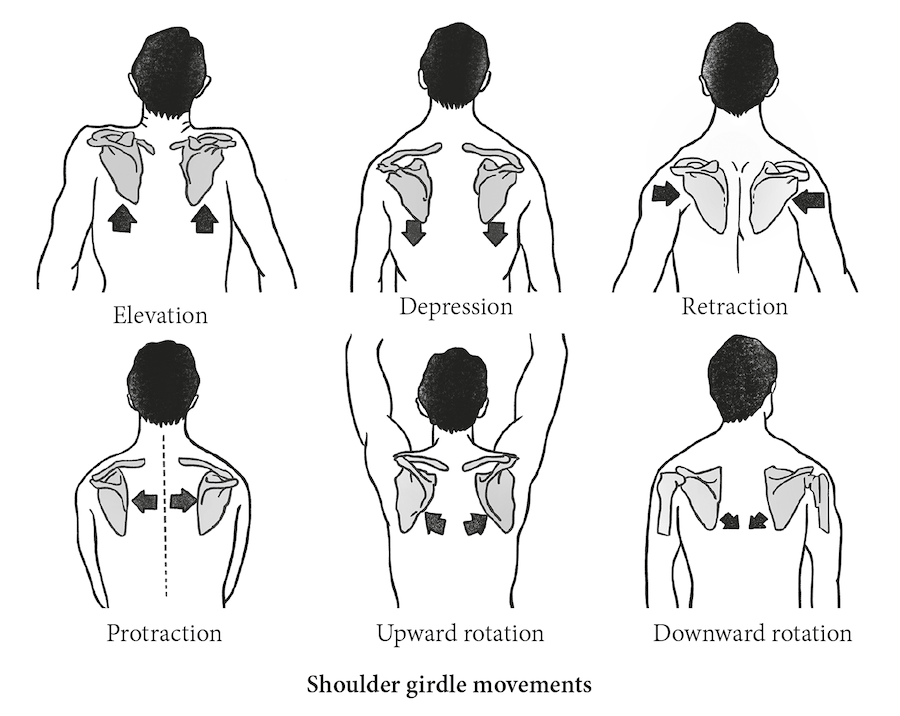In the wider yoga community, there tends to be a preference for drawing the shoulder blades down in almost every asana and often a belief that this is ‘right’ and that allowing the shoulder blades to lift towards the ears is ‘wrong’. Let’s explore this topic by first looking at the anatomy of the shoulder girdle.
The shoulder complex is made up of three bones: the upper arm bone (humerus), the shoulder blade (scapula), and the collarbone (clavicle). The relationship between these three bones creates a huge range of movement for the upper limb: the main function being to position the hand to affect functional activities. The ‘scapulohumeral rhythm’ first described by Codman (1934) is the pattern of muscle contractions and motion that occurs between the scapula and the humerus.
The shoulder girdle is made up of the clavicle and the scapula which articulate to form a cage-like structure that sits on the side of the ribcage and connects the upper limb to the axial skeleton.
Also known as the glenohumeral joint, the shoulder joint is a ball-and-socket joint that involves the articulation between the head of the humerus and the shallow socket (glenoid fossa) of the scapula. The shoulder joint has the greatest mobility of all our joints, but it is therefore the least stable joint in the body.
The scapula serves as a site for attachment for many muscles and provides a stable base from which shoulder joint mobility occurs.
The coracoid process of the scapula is a hook-like projection, which lies just underneath the clavicle and serves as the attachment site for pectoralis minor and the short head of biceps. The acromion forms the top of the shoulder complex, and is a large, somewhat oblong process, which overhangs the glenoid cavity of the shoulder joint. The acromioclavicular joint connects the clavicle to acromion. On the lateral surface of the scapula is the glenoid fossa, the socket of the shoulder joint.
There are no bony attachments, ligaments or tendons that connect the scapula to the ribcage. A suction mechanism is provided by the muscular attachments of the serratus anterior and subscapularis which holds the scapula close to the ribcage and allows it to glide over the ribcage (Peat 1986). This greatly enhances the range of movement of the shoulder girdle and consequently the upper limb.
We will now explore six main movements of the shoulder girdle:
Elevation is moving the shoulder girdle up towards the ear, while depression is moving the shoulder girdle down away from the ear. Trapezius is a large muscle that originates at the base of the skull and the spinous processes of C2 through T12. It inserts on the clavicle and the scapula. The upper fibers elevate the shoulder girdle while the lower fibers depress the shoulder girdle.
Protraction is drawing the scapula away from the midline of the body. In full scapular protraction the scapula follows the contour of the ribs which results in the glenoid fossa facing forward with the full scapula in contact with the rib cage (Levangie and Norkin 2005).
Retraction is moving the scapula towards the midline of the body and tends to be coupled with thoracic extension.
Upward rotation describes a swinging movement roughly in the frontal plane where the lower tip of the scapula moves up and out away from the midline. In a neutral scapular position the glenoid fossa faces laterally, but as the scapula begins to upwardly rotate the glenoid fossa begins to face upwards. This plays a significant role in increasing the range of movement of the arm overhead. This motion also places the glenoid fossa in a position to support and stabilize the head of the raised humerus (Neumann 2009). Typically, the shoulder girdle can upwardly rotate up to 60°.
Downward rotation describes the swinging movement whereby the lower tip of the scapula moves down and towards the midline. Downward rotation of the scapula occurs as the arm is returned to the side from a raised position.
The shoulder girdles are there to facilitate the large range of movement of the upper limb.
Raising our arms above our head is facilitated by elevation, protraction and upward rotation of the shoulder girdle. By choosing to depress our shoulder girdles before we lift our arms, we are impeding these other important movements.
Try it for yourself. Start by fully depressing your scapulae and then keeping this depression, lift your arms above your head. How does the movement feel and how much range do you have? Now, release that active depression and once again raise your arms. Can you feel the difference? Cueing your students to depress their scapulae isn’t incorrect but add this cue as a refinement once the arms have moved freely.
References:
Codman, E. (1934) The Shoulder. Boston: Thomas Todd Co.
Levangie, P. and Norkin, C. (2005) Joint structure and function: A comprehensive analysis. 4th ed.Philadelphia: The F.A. Davis Company.
Neumann, D. (2009) Kinesiology of the Musculoskeletal System: Foundations for Physical Rehabilitation. 2nd ed. St. Louis: Mosby.
Peat, M. (1986) ‘Functional anatomy of the shoulder complex.’ Phys Ther 66, 1855-1865.


